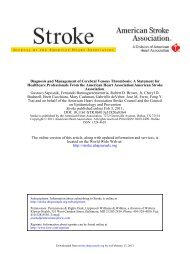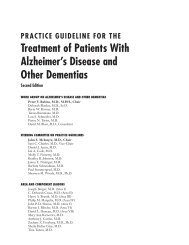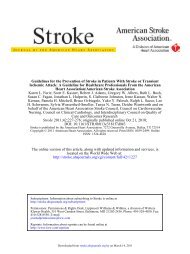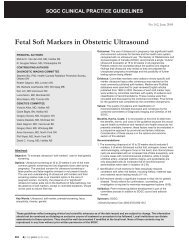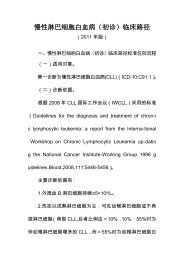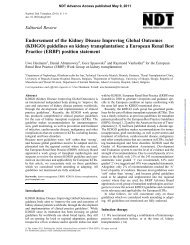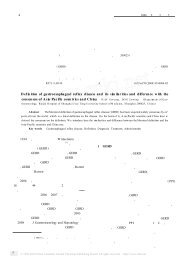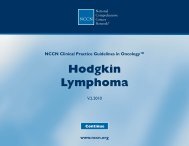EFNS guidelines on pharmacological treatment of neuropathic pain
EFNS guidelines on pharmacological treatment of neuropathic pain
EFNS guidelines on pharmacological treatment of neuropathic pain
You also want an ePaper? Increase the reach of your titles
YUMPU automatically turns print PDFs into web optimized ePapers that Google loves.
Pharmacological <strong>treatment</strong> <strong>of</strong> <strong>neuropathic</strong> <strong>pain</strong> 1157and indicati<strong>on</strong>s for useÕ). Sec<strong>on</strong>d/third-line therapyincludes opioids (potential safety c<strong>on</strong>cerns in n<strong>on</strong>cancer<strong>pain</strong>; see ÔAdverse events and indicati<strong>on</strong>s foruseÕ) and LTG (level B). Treatments with weaker/lack<strong>of</strong> efficacy include capsaicin, mexiletine, OXC, SSRI,topiramate (level A), memantine, mianserin andtopical cl<strong>on</strong>idine (level B). There is low strength <strong>of</strong>evidence and safety c<strong>on</strong>cerns for CBZ (see ÔAdverseevents and indicati<strong>on</strong>s for useÕ) (level C) and limitedsupport for the use <strong>of</strong> dextrometorphan and levodopa.Discrepant results have so far been obtained withvalproate.HIV-associated polyneuropathy has been foundrefractory to most currently assessed drugs. This maybe due to particular mechanisms <strong>of</strong> <strong>pain</strong> in this <strong>of</strong>tenprogressive c<strong>on</strong>diti<strong>on</strong> and/or to a high placebo resp<strong>on</strong>se,observed in many trials. Only LTG has beenreported efficacious in a subgroup <strong>of</strong> patients receivingART in <strong>on</strong>e class I trial, but a smaller class II trialreported totally opposite results (level B).Postherpetic neuralgiaPostherpetic neuralgia is a <strong>pain</strong>ful aftermath <strong>of</strong> herpeszoster. The most important risk factors for PHNare old age and severe acute <strong>pain</strong>. Patients with PHNcomm<strong>on</strong>ly describe a c<strong>on</strong>stant generally burning <strong>pain</strong>,an intermittent <strong>pain</strong> with lancinating or shootingquality, and brush-induced allodynia is observed innearly 90% <strong>of</strong> cases. In an individual patient, anycomp<strong>on</strong>ent can be the most distressing feature <strong>of</strong> the<strong>pain</strong> [60].AntidepressantsThe TCAs amitriptyline (average dosages 65–100 mg/day), nortriptyline (average 89 mg), desipramine(average 65–73 mg) are effective in PHN <strong>on</strong> the basis <strong>of</strong>three class I–II placebo-c<strong>on</strong>trolled trials with a combinedNNT ¼ 2.6 (CI 2.1–3.5) [class I SR: 8,9]. In twosmall head-to-head comparative trials, the antidepressantmaprotiline has been found slightly less effectivethan amiptriptyline [class II: 61] and nortriptyline aseffective as amitriptyline, but better tolerated [class II:62]. There are no RCTs <strong>of</strong> the efficacy <strong>of</strong> SSRIs orSNRIs in PHN.AntiepilepticsGabapentin 1800–3600 mg/day [class I: 63,64] andpregabalin 150–600 mg/day [class I: 65,66] have c<strong>on</strong>sistentlyshown efficacy in PHN, with an NNT <strong>of</strong> 4.4(CI 3.3–6.1) for GBP and 4.9 (3.7–7.6) for pregabalin[class I SR: 9]. Very good results have recently beenreported with valproate 1000 mg in <strong>on</strong>e study with anNNT ¼ 2.1 (1.4–4.2) [66, class II].Topical <strong>treatment</strong>sRepeated applicati<strong>on</strong> <strong>of</strong> lidocaine patches (5%) hasshown efficacy in PHN patients with allodynia in threeplacebo-c<strong>on</strong>trolled studies, all with short durati<strong>on</strong> (upto 3 weeks) [class II: 68–70]. One crossover study (in 32patients) did not report baseline levels <strong>of</strong> <strong>pain</strong> and usedan enriched enrolment (i.e. <strong>on</strong>ly patients with clinicalopen-label improvement with topical lidocaine wererecruited) [68]. Two studies [69,70) were post-hoc analysesfrom larger trials performed in multiple-aetiology<strong>neuropathic</strong> <strong>pain</strong> group [class II: 71] or in PHN patients[68].Topical capsaicin 0.075% has been found effective,though to a small degree, in two parallel group RCTsand caused burning sensati<strong>on</strong> in most subjects [class I:72,73].OpioidsOxycod<strong>on</strong>e, morphine and methad<strong>on</strong>e have shownefficacy <strong>on</strong> PHN in two crossover placebo-c<strong>on</strong>trolledRCTs [class I: 74,75]. One n<strong>on</strong>-placebo-c<strong>on</strong>trolledparallel group study reported better efficacy <strong>of</strong> highversus low dosages <strong>of</strong> levorphanol in PHN patients(extracted from a larger group <strong>of</strong> patients with multiple-aetiology<strong>neuropathic</strong> <strong>pain</strong>s) [class I: 76]. Thecombined NNT for str<strong>on</strong>g opioids in PHN is estimated2.7 (CI 2.1–3.7) [class I SR: 9]. In <strong>on</strong>e trial comparingslow-release morphine (91 mg/day, range 15–225) andmethad<strong>on</strong>e (15 mg/day) with TCAs and placebo, <strong>pain</strong>relief was significantly greater with morphine than withnortriptyline, whereas the analgesic efficacy <strong>of</strong> methad<strong>on</strong>ewas comparable with that <strong>of</strong> TCAs [75]. Therewere significantly more withdrawals during the opioid<strong>treatment</strong> than during the TCA <strong>treatment</strong>, but cognitivedeteriorati<strong>on</strong> was seen <strong>on</strong>ly with TCAs.Tramadol (mean dosage 275 mg/day, up to 400 mg/day) was shown moderately effective <strong>on</strong>ly <strong>on</strong> somemeasures <strong>of</strong> sp<strong>on</strong>taneous <strong>pain</strong> intensity in PHN, withan NNT ¼ 4.8 (CI 2.6–26.9) [class I: 77]; in this study,<strong>on</strong>ly patients with <strong>pain</strong> lasting for less than 1 year wereincluded, thus several patients tended to recover sp<strong>on</strong>taneouslyduring the trial, which accounts for the highrate <strong>of</strong> placebo resp<strong>on</strong>se.Other <strong>treatment</strong>sThe NMDA-antag<strong>on</strong>ists dextrometorphan and memantine,as well as the benzodiazepine lorazepam, areinefficacious in PHN [class I/II: 47,48,78,79].Recommendati<strong>on</strong>sIn PHN, drugs with established efficacy include TCAs,GBP, pregabalin and opioids (level A, class I trials).Drugs with lower efficacy or limited strength <strong>of</strong>Ó 2006 <str<strong>on</strong>g>EFNS</str<strong>on</strong>g> European Journal <strong>of</strong> Neurology 13, 1153–1169



